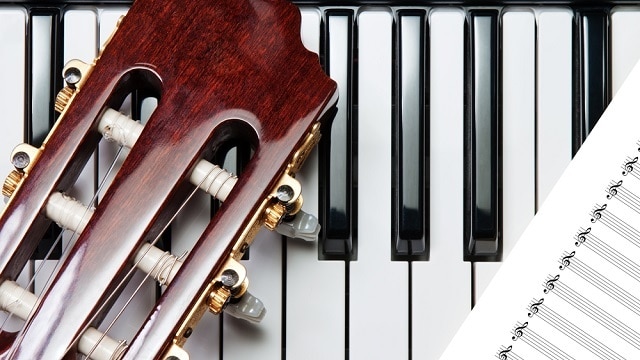Written by: Ray Nelson
“I can’t count how many times over my teaching career I have heard students say this. There is such an interest out there to be able to play in a band together with other musicians and yet I have often wondered why we see so few keyboard players doing this. There seems to be no lack of guitar players, and even though today’s pop music seems to be focused on the guitar sounds, I believe there is a reason for this.”

When students are taught how to play the guitar, the focus of learning is built around playing chords, and they learn from the get-go how to develop a sense of rhythm, which fits in perfectly in being able to play together with other musicians. On the other hand, learning the keyboard has traditionally been taught from a reading, solo perspective to learning music. This does not cross over well to the group playing environment, where your ability to listen to the other musicians and to play “off” each other is critical in developing a team sound.
The accompaniment skills that Simply Music teaches are, I feel, among the most important skills we can teach our students to develop, and will set them up for successfully being able to play together with other musicians in their musical journey.
So how do we play keyboards in a band?
This is a vast topic today, as the role of the keyboardist has evolved over the years, from being primarily a piano player, to today utilizing multiple synth keyboards, each with a specific role, as well as computer technology with sound libraries and effects! My own journey has been like this, where today my Mac computer is a key part of my keyboard rig set-up when I play in bands.
Even though technology is changing, I think there are elements of keyboard playing that will never change when one is playing in a group or band setting.
The Role of the Keyboardist
I liken today’s role of the keyboardist to that of being a painter. You are part of the picture, being given a paint brush with which to add color. But the rest of the band is also a part of the picture and they are also painting colors on the canvas, so you need to look at each other’s colors and keep in mind how you are creating the big picture together!
What colors the keyboardist may use can depend on the type of song being played. Maybe a simple chord rhythm only is needed, or maybe a simple melodic fill can be used. There are many nuances to songs, and so developing a good listening ear is critical to knowing what/when to play.
Here are a few tips that keyboardist will find important to develop in their playing:
![]() Use sounds on the keyboard that will complement the overall sound that is being created by the band. Warm electric pianos, strings, synth pads, and organ sounds are mostly what I find useful.
Use sounds on the keyboard that will complement the overall sound that is being created by the band. Warm electric pianos, strings, synth pads, and organ sounds are mostly what I find useful.
![]() Move around on the keyboard. Don’t always play in the middle register, as your sounds will not cut through with what the band is playing. Using the higher register for strings and the lower part of the keyboard for the pads will really help your sounds stand out more.
Move around on the keyboard. Don’t always play in the middle register, as your sounds will not cut through with what the band is playing. Using the higher register for strings and the lower part of the keyboard for the pads will really help your sounds stand out more.
![]() Listen-Listen-Listen! Is what I’m playing complementing the singers and other instruments? Don’t play the same pattern that the bass player is playing, or same high melody line that is being sung by the singers.
Listen-Listen-Listen! Is what I’m playing complementing the singers and other instruments? Don’t play the same pattern that the bass player is playing, or same high melody line that is being sung by the singers.
![]() Remember that the chord chart for the song is your map only. What you do with that map and how you use it is up to you. Having a solid understanding of the chord shapes and chord inversions needs to be in place first, so you can focus more on using the chords to create their own arrangement of the song, with little fills and embellishments.
Remember that the chord chart for the song is your map only. What you do with that map and how you use it is up to you. Having a solid understanding of the chord shapes and chord inversions needs to be in place first, so you can focus more on using the chords to create their own arrangement of the song, with little fills and embellishments.
![]() My golden rule is always “Less is more!” Don’t feel you need to always play. A simple chord carefully played with the right sound can go a long way in creating the right kind of atmosphere for the song.
My golden rule is always “Less is more!” Don’t feel you need to always play. A simple chord carefully played with the right sound can go a long way in creating the right kind of atmosphere for the song.
There is so much more that could be discussed here, but I have found that many times students just need to learn the basics of playing accompaniment in a band and to experience this first. It’s always going to be a journey in developing your skills and the more you do it, the better you get at it! The other day, my daughter had the opportunity to play her first “gig” in her youth band at church, and she was blown away by how easy it was to add so much to the overall sound of the band by only playing simple chords using a keyboard! The analogy of less equaling more in a band setting is so true!
So if you want to play in a band, grab some chord charts, and find some songs you can play along with on YouTube. At your next group keyboard class, have everyone take turns playing along with the band on YouTube and give them first hand experience to see how fun and easy using chords can be!







